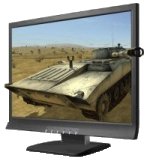Are You 1337?
 In a world where online gaming is very common, how do you separate the elite from the newbie’s? Shuttle Computer’s new XPC 1337 products cater towards the most elite gamers seeking the absolute best performance. XPC 1337 systems deliver blazing fast framerate with outstanding visuals in all popular online games including World of Warcraft, Counter Strike, Battlefield and others! These systems aren’t for newbie’s though; only the 1337 gamers can harness the performance of XPC 1337 systems.
In a world where online gaming is very common, how do you separate the elite from the newbie’s? Shuttle Computer’s new XPC 1337 products cater towards the most elite gamers seeking the absolute best performance. XPC 1337 systems deliver blazing fast framerate with outstanding visuals in all popular online games including World of Warcraft, Counter Strike, Battlefield and others! These systems aren’t for newbie’s though; only the 1337 gamers can harness the performance of XPC 1337 systems.Shuttle XPC 1337 systems are different from the regular XPC system offerings. These differences include specific hardware components, internal case designs and hand painted cases. A paint-matched mouse and keyboard are also included with XPC 1337 systems. XPC 1337 systems offer the absolute best technologies available. This all comes together to make one unique system with performance to boot—only the 1337 apply.
Unique Hand Paint with Automotive Paint by Smooth Creations What happens when the renowned Smooth Creations spends 8 hours in their labs with an XPC? Something striking to behold, and thrilling to game with. Each SDXi is individually hand painted with real automotive finish, giving each unit its own unique feel. Shuttle XPC 1337 systems are coated with premium automotive paint. The glossy paint provides a look unique to 1337 system.

 The Personal Cinema System has a range of potential uses. Content is fed to the headset via the small box you see pictured. Dubbed the Liberator, this box includes two USB ports, a Compact Flash slot and composite, component and S-Video inputs. Thanks to this wide range of connectivity, you could connect your PC (for games, Web browsing etc), video game console, video iPod, DVD players and anything else you can think of really.
The Personal Cinema System has a range of potential uses. Content is fed to the headset via the small box you see pictured. Dubbed the Liberator, this box includes two USB ports, a Compact Flash slot and composite, component and S-Video inputs. Thanks to this wide range of connectivity, you could connect your PC (for games, Web browsing etc), video game console, video iPod, DVD players and anything else you can think of really.